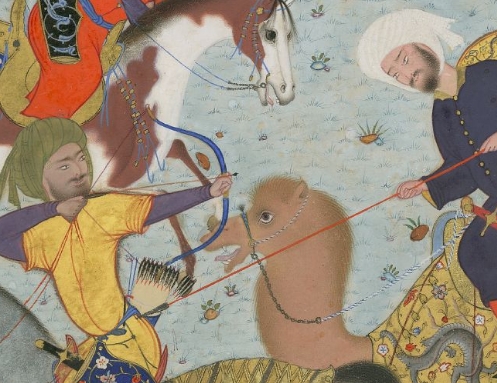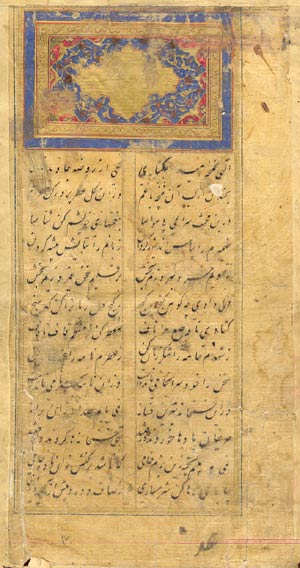Haft Aurang on:
[Wikipedia]
[Google]
[Amazon]



 ''Haft Awrang'' (, meaning "Seven Thrones") by the
''Haft Awrang'' (, meaning "Seven Thrones") by the
Explore the Freer Jami
{{Webarchive, url=https://web.archive.org/web/20220104075728/https://asia.si.edu/exhibitions/online/loveYearning/base.html/ , date=2022-01-04 15th-century Persian books Poems in Persian Persian words and phrases Timurid literature



 ''Haft Awrang'' (, meaning "Seven Thrones") by the
''Haft Awrang'' (, meaning "Seven Thrones") by the Persian
Persian may refer to:
* People and things from Iran, historically called ''Persia'' in the English language
** Persians, the majority ethnic group in Iran, not to be conflated with the Iranic peoples
** Persian language, an Iranian language of the ...
poet Jami
Nūr ad-Dīn 'Abd ar-Rahmān Jāmī (; 7 November 1414 – 9 November 1492), also known as Mawlanā Nūr al-Dīn 'Abd al-Rahmān or Abd-Al-Rahmān Nur-Al-Din Muhammad Dashti, or simply as Jami or Djāmī and in Turkey as Molla Cami, was a ...
is a classic of Persian literature
Persian literature comprises oral compositions and written texts in the Persian language and is one of the world's oldest literatures. It spans over two-and-a-half millennia. Its sources have been within Greater Iran including present-day ...
composed some time between 1468 and 1485. Jami completed the work as seven books following a masnavi
The ''Masnavi'', or ''Masnavi-ye-Ma'navi'' (, DIN 31635, DMG: ''Mas̲navī-e maʻnavī''), also written ''Mathnawi'', or ''Mathnavi'', is an extensive poem written in Persian language, Persian by Jalal al-Din Muhammad Rumi, also known as Rumi. I ...
format:
* "Selselat adh-dhahab" (, "Chain of Gold"): a collection of didactic anecdotes
* "Yusof-o Zulaikhā" (, " Joseph and Zulaikha"): the romance of Joseph
Joseph is a common male name, derived from the Hebrew (). "Joseph" is used, along with " Josef", mostly in English, French and partially German languages. This spelling is also found as a variant in the languages of the modern-day Nordic count ...
and Zulaikha, wife of Potiphar
Potiphar ( ; ; ) is a figure in the Hebrew Bible and the Quran. His name possibly indicates the same figure as Potiphera ().
Potiphar is the captain of the guard for a pharaoh who is said to have purchased Joseph as a slave and, impressed by hi ...
based on the Islamic traditions.
* "Sabhat al-abrār" (, "Rosary of the Pious"): another collection of didactic anecdotes
* "Salaman-o Absāl" (, Salaman and Absal): A doomed romance between a prince and his nursemaid. The original story is Greek, translated in the early Islamic times to Arabic by Ibn Hunain and then rendered into Persian poem by Jami. Dehkhoda
Allameh Ali-Akbar Dehkhodā (; 1879 – March 9, 1956) was a prominent Iranian literary writer, philologist, and lexicographer.
He was the author of the '' Dehkhoda Dictionary'', the most extensive dictionary of the Persian language publis ...
suggests this story might have an Israelite origin.
* "Tohfat ol-ahrār (, "Gift of the Free")
* "Layli-o Majnun" (, "Layla and Majnun
''Layla and Majnun'' ( "Layla's Mad Lover"; ) is an old story of Arab origin, about the 7th-century Arabian poet Qays ibn al-Mulawwah and his lover Layla bint Mahdi (later known as Layla al-Aamiriya).
"The Layla-Majnun theme passed from ...
")
* " Kherad-nâme-ye Eskandari" (, "Alexander's Book of Wisdom") account of events leading up to Alexander's death.
The term ''Haft Awrang'' itself is a reference to the seven stars that form the Big Dipper
The Big Dipper (American English, US, Canadian English, Canada) or the Plough (British English, UK, Hiberno-English, Ireland) is an asterism (astronomy), asterism consisting of seven bright stars of the constellation Ursa Major; six of them ar ...
(the Plough or ).
Religion, philosophy, and ethics of Sufi
Sufism ( or ) is a mysticism, mystic body of religious practice found within Islam which is characterized by a focus on Islamic Tazkiyah, purification, spirituality, ritualism, and Asceticism#Islam, asceticism.
Practitioners of Sufism are r ...
origin lie at the root of all seven ''masnavis''.
Freer Jami
Between 1556 and 1565, while he was governingMashad
Mashhad ( ; ), historically also known as Mashad, Meshhed, or Meshed in English, is the second-most-populous city in Iran, located in the relatively remote north-east of the country about from Tehran. In the Central District of Mashhad ...
, Prince Sultan Ibrahim Mirza
Ibrahim Mirza, Solṭān Ebrāhīm Mīrzā, in full Abu'l Fat'h Sultan Ibrahim Mirza (; April 1540 – 23 February 1577) was a Persian prince of the Safavid dynasty, who was a favourite of his uncle and father-in-law Shah Tahmasp I, but who was ...
, nephew and son-in-law of Shah Tahmasp I
Tahmasp I ( or ; 22 February 1514 – 14 May 1576) was the second shah of Safavid Iran from 1524 until his death in 1576. He was the eldest son of Shah Ismail I and his principal consort, Tajlu Khanum.
Tahmasp ascended the throne after the ...
, commissioned his own atelier of painters and calligraphers to create a sumptuous illustrated version of the Haft Awrang, producing one of the undoubted masterpieces of the Persian miniature
A Persian miniature (Persian language, Persian: نگارگری ایرانی ''negârgari Irâni'') is a small Persian painting on paper, whether a book illustration or a separate work of art intended to be kept in an album of such works called a ...
, now in the Freer Gallery of Art
The Freer Gallery of Art is an art museum of the Smithsonian Institution in Washington, D.C. focusing on Asian art. The Freer and the Arthur M. Sackler Gallery together form the National Museum of Asian Art in the United States. The Freer and ...
, and known as the Freer Jami.
History of the Freer Jami manuscript
The manuscript's journey can be traced across the centuries and several empires through official seal stampings on its pages and variations in materials and styles particular to certain periods and locations throughout thePersia
Iran, officially the Islamic Republic of Iran (IRI) and also known as Persia, is a country in West Asia. It borders Iraq to the west, Turkey, Azerbaijan, and Armenia to the northwest, the Caspian Sea to the north, Turkmenistan to the nort ...
, India
India, officially the Republic of India, is a country in South Asia. It is the List of countries and dependencies by area, seventh-largest country by area; the List of countries by population (United Nations), most populous country since ...
, and Europe
Europe is a continent located entirely in the Northern Hemisphere and mostly in the Eastern Hemisphere. It is bordered by the Arctic Ocean to the north, the Atlantic Ocean to the west, the Mediterranean Sea to the south, and Asia to the east ...
.
Ibrahim Mirza may have originally commissioned the manuscript's creation to celebrate the wedding of Shah Tahmasp I. The romantic and philosophical themes of Jami's seven masnavis would have been appropriate as a gift to a recently married man. At least five calligraphers contributed to the manuscript's creation: Shah Mahmud Nishapuri, Rustam 'Ali, Muhibb 'Ali, Malik al-Daylami, and Ayshi ibn Ishrati. It was also transcribed in three different cities: Mashhad, Qazvin, and Herat. Once the individual contributions were brought together and assembled, further decoration was added. The manuscript includes copious illuminations throughout the seven poems, including 28 full-page paintings featuring complex arrangements of detailed architectural settings and idealized figures.
The first indication of transfer can be found on a page with multiple seal impressions indicating that around 1609, the Safavid shah 'Abbas I donated the manuscript to the dynastic shrine at Ardabil
Ardabil (, ) is a city in northwestern Iran. It is in the Central District (Ardabil County), Central District of Ardabil County, Ardabil province, Ardabil province, Iran, serving as capital of the province, the county, and the district.
The ...
.
Around the mid-seventeenth century, the manuscript found its way to the Mughal Empire
The Mughal Empire was an Early modern period, early modern empire in South Asia. At its peak, the empire stretched from the outer fringes of the Indus River Basin in the west, northern Afghanistan in the northwest, and Kashmir in the north, to ...
in India. A page with inspection notes and more seal impressions was added to the end folio which references Shah Jahan I (r. 1628-1658) and his successor Awrangzib (r.1658-1707).
Scholars believe it travelled back to the region which is now Iran by the late eighteenth or nineteenth century, as the first folio exhibits illumination in the Qajar
The Guarded Domains of Iran, alternatively the Sublime State of Iran and commonly called Qajar Iran, Qajar Persia or the Qajar Empire, was the Iranian state under the rule of the Qajar dynasty, which was of Turkic origin,Cyrus Ghani. ''Iran an ...
period style (1785-1906). It most likely acquired its current decorated 'lacquer' covers and red leather spine in Europe after that. The next verified step in the manuscript's journey is in a sale catalog from 1926 Milan, Italy, where archaeologist and collector, Hagop Kevorkian
Hagop Kevorkian (; 1872 – 1962) was an Armenian-American archeologist, connoisseur of art, and collector. Originally from Kayseri, and a graduate of the American Robert College in Istanbul, he settled in New York City in the late 19th century, ...
acquired it. The Smithsonian Institution
The Smithsonian Institution ( ), or simply the Smithsonian, is a group of museums, Education center, education and Research institute, research centers, created by the Federal government of the United States, U.S. government "for the increase a ...
purchased the manuscript from him in 1946. It remains in the Washington D.C. Freer Gallery
The Freer Gallery of Art is an art museum of the Smithsonian Institution in Washington, D.C. focusing on Asian art. The Freer and the Arthur M. Sackler Gallery together form the National Museum of Asian Art in the United States. The Freer and S ...
. All of the manuscript's pages can be viewed in the Smithsonian Institution's online database.
See also
* Sadd-i IskandariReferences
External links
Explore the Freer Jami
{{Webarchive, url=https://web.archive.org/web/20220104075728/https://asia.si.edu/exhibitions/online/loveYearning/base.html/ , date=2022-01-04 15th-century Persian books Poems in Persian Persian words and phrases Timurid literature